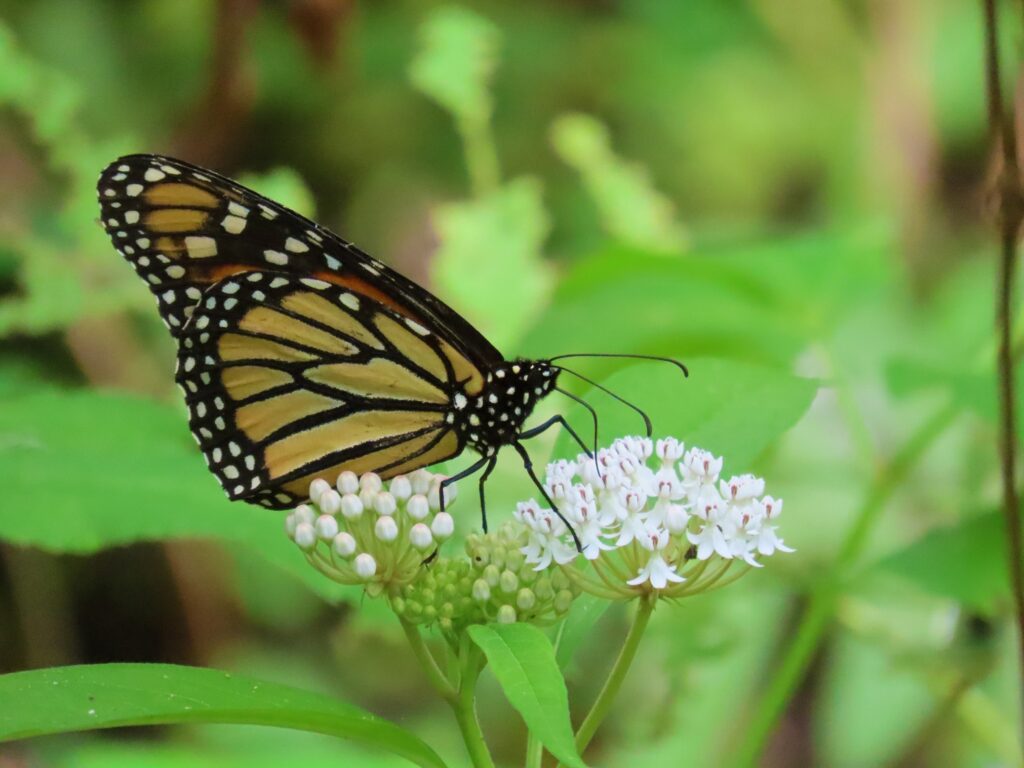
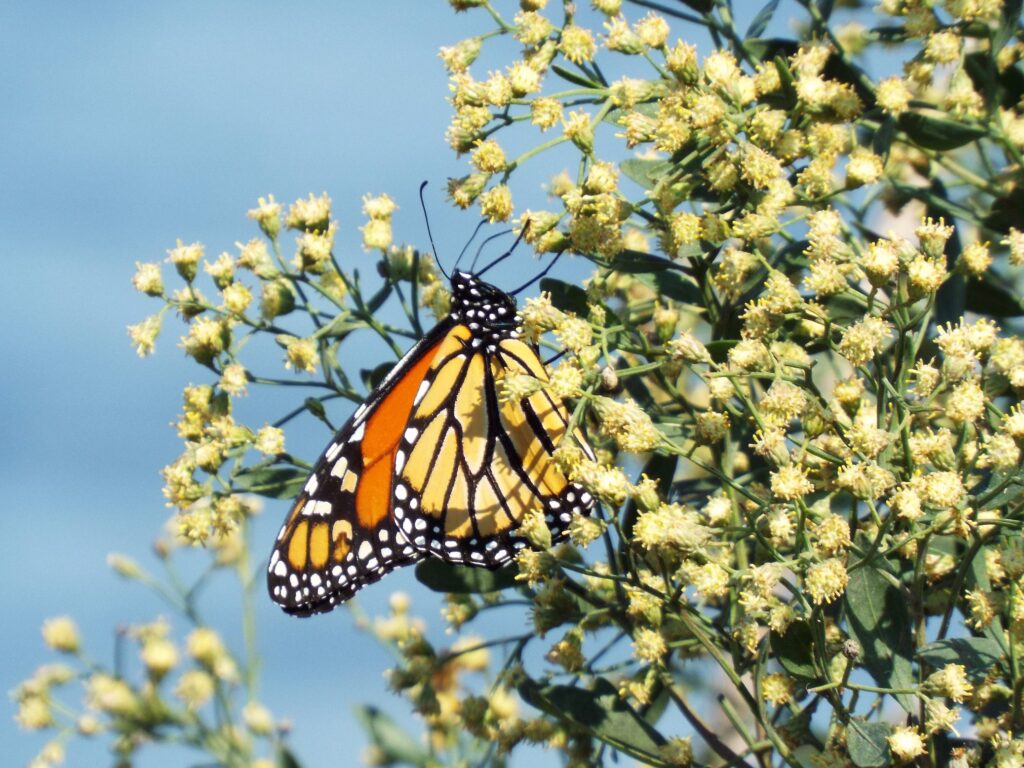

This week for Flora and Fauna Friday our guest needs no introduction, the Monarch (Danius plexippus).
The Monarch is a large butterfly in the Brushfoot family. They’re rich in a burnt-orange above that’s divided by veins of black within black borders. The fringes of their wings are spattered with numerous white polka-dots that spread downward across their downy black body.
Monarchs are interesting in that they feed on Milkweed, a plant that produces a white sap full of toxins. The chemicals in this sap induce cardiac arrest in vertebrates, so herbivores avoid it. Monarchs use this poison to their own advantage. By eating exclusively Milkweed the caterpillars can incorporate these toxins into their bodies, making them as deadly as the plant. However, being poisonous is only useful if the thing that wants to eat you knows about it before it eats you. Otherwise you both end up dead.
Monarchs advertise their toxicity through coloration. Orange and black are the universal colors of danger in the animal kingdom. This patterning is called aposematic coloration and it’s a double-edged sword. Being colorful makes you super obvious to predators, which is a blessing and a curse. On one hand, it decreases your chance of being attacked if the would be attacker can read your pattern. Yet on the other hand, it places you in greater danger from an unobservant, unknowing, or uncaring predator. On top of this, some animals only pretend to be toxic to bluff predators. The Viceroy butterfly is a good example of this and it does an admirable job mimicking our Monarch. Mimics further complicate this predator-poison-prey relationship, turning it into a guessing game for all involved.
The Monarch is a rock star of entomology. It’s one of the few bugs that‘s famous rather than infamous. Regrettably, they’re famous due to their perilous position. Monarchs are a migratory butterfly. Butterflies don’t migrate in the same way birds do, circuiting the continent annually throughout their lives. Instead, butterflies make multi-generation migrations. In late summer, Monarchs begin flying south. They channel down our coastline, flowing from beach to beach in undulating orange waves like an autumn breeze over the ocean. Most make their way to Mexico, although many of those local to the Lowcountry snowbird in Florida instead. Here the butterflies overwinter. When spring sets in the tattered and battered critters fly north in rolling winds. A pilgrimage to lay their eggs over the Milkweed of the Southern US before returning to the Earth. Their children and grand-children continue to leapfrog up the states until winter begins again. The next butterflies to land south of the border are often the great-great-grandchildren of those who made the journey the year before. The Monarch is in danger because of this drawn out migration and its specialized larval diet. Expanding residential development in the Midwest and the over-reliance on pesticides in agriculture are destroying their Milkweed nurseries. The over-development of barrier islands is degrading the corridors of wildflowers they rely on as they migrate through on their way south. On top of that, uncontrollable logging on the mountains of Central America is erasing their wintering grounds. Across the board, Monarchs are getting hammered. They’re not in danger of going extinct but the possibility of this annual journey perishing, reducing the species to but a few sedentary populations, is very much real.


This week for Flora and Fauna Friday it’s the purple haze of coming autumn days, Blue Mistflower (Conoclinium coelestinum).
Blue Mistflower is a clumping perennial most often found in sunny wet patches along woodland edges. It grows densely and fairly low, spreading outward as it goes. Leaves are held apart and opposite each other. Leaves that are almost triangular, crinkly, and a dark-green with burgundy accents on burgundy stems that hold up flower heads. Each stem ties together a bouquet of blossoms at its peak. Blossoms of blue and violet melted over one another onto fuzzy filamentous petals. Each kernel of color is a cluster of flowers clumped with others into an arrangement that’s fractally reflected across the stand of plants.
A purple haze appears to hover above the vegetation to the far off observer. Those who approach find a mist of blue punctured by lively orange and yellows, contrasting flashes fluttering like leaves over smoke. Blue Mistflower is a wondrous nectar plant. It’s placement at the nexus between wetland, forest, and glade creates the opportunity to view many species on pollinators seldom seen together, intermixed with one another. A fog of flies, bees, & butterflies surround our flower and settle like dew upon its petals. We see this phenomenon a lot with our late blooming wetland wildflowers but it is never less impressive with subsequent iterations or alternative floral presentations. Our wetland plants are often prosperous where they find purchase but isolated from their kin. So they bribe the bugs as heavily as they can for even the chance of them delivering pollen to off.
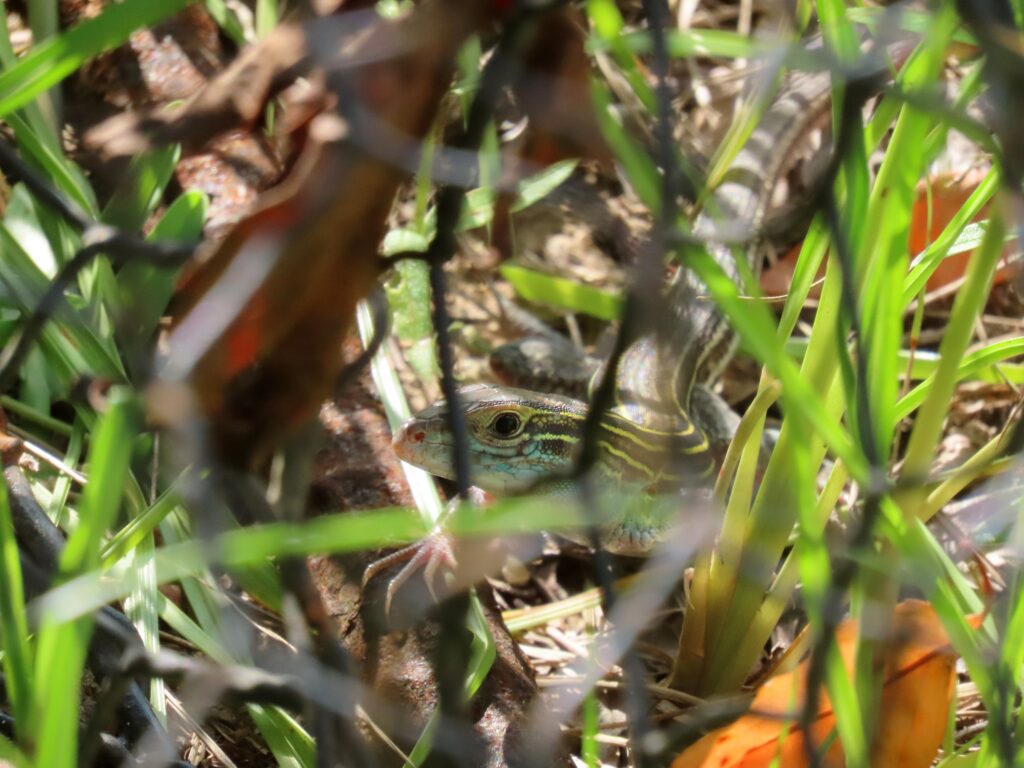

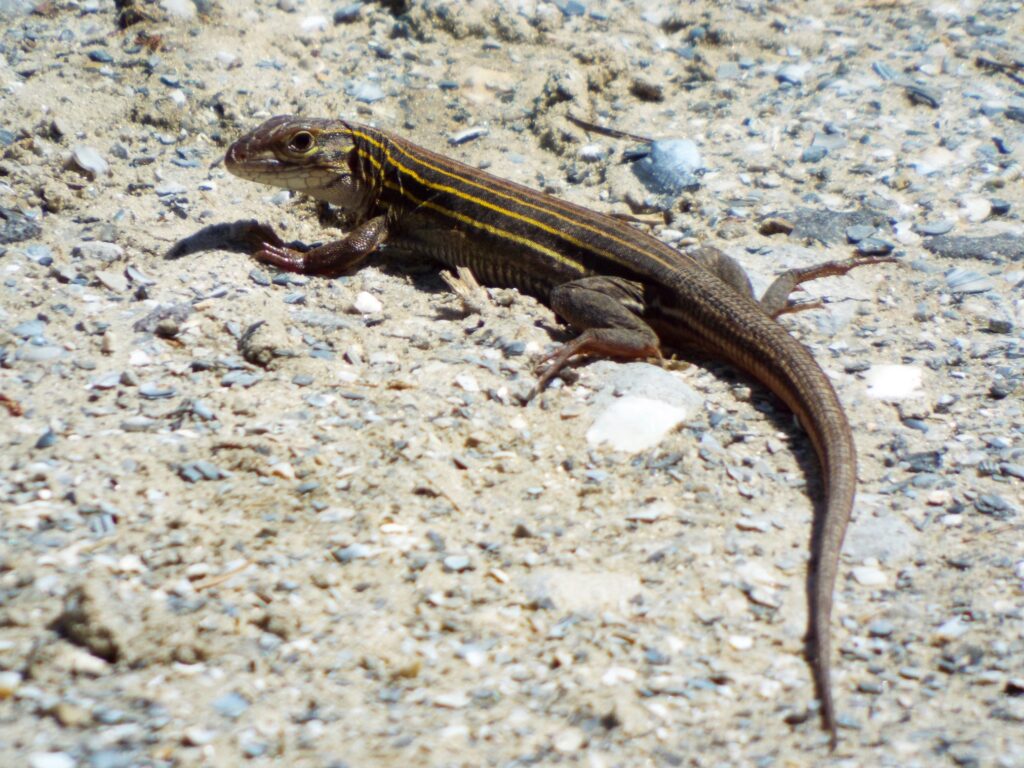
This week for Flora and Fauna Friday we have the striped speedster of the sand barrens, the Six-lined Racerunner (Aspidoscelis sexlineatus).
The Six-lined Racerunner is a species of lizard common on the hot dry sands of Edisto Island. They love heat and relish in the dog days of summer. You’ll never find them in the lowlands of the island but they flee in droves upon our sandy hills. They’re long and somewhat slender with short legs and extended toes. Their back is charcoal-black with a central gray-brown stripe. Their body is flanked by six lemon-yellow lines, three per side, that flow behind the eye and bleed into the tail. The male’s throat and belly are washed in turquoise that flashes at that eye as he blinks across pale sands. The species has a jittery appearance. Moving in rapid, jerking movements. These tweaky telltale signs betray their most novel quality.
Racerunners are quick little things. They explode from their footings at the slightest provocation. Their long toes anchor into the soft sands and propel our reptile elsewhere in the blink of an eye. Their primary predators are the Southern Black Racer (Coluber constrictor priapus), the Loggerhead Shrike (Lanius ludovicianus), and the American Kestrel (Falco sparverius). Their speed is both defense and offense, moving them out of harm’s way and launching them into prey the same way. Six-lined Racerunners eat insects. They most often forage casually under leaves and logs for little critters but can utilize their quickness for high-speed snacking when the opportunity presents itself. Also, they don’t shed their tails like most of our other lizards. They need it as a counterbalance while sprinting. Leaving it behind would be a death sentence.
Six-lined Racerunners maintain an extremely high body temperature during the day, typically above 100°F. Normal reptiles have a low core temperature which slows their metabolism and saves calories. Racerunners exploit the heat of summer to drive their metabolism to mammal-like levels. This grants them the gift of continuous acceleration. Many reptiles can produce explosive speed on demand but it comes at the cost of extended exhaustion. Their sluggish metabolisms takes forever to recharge the energy stores they burned. Racerunners worked around this and can run for longer distances with shorter rests in between. Meaning they can save energy like a reptile at night or during winter but can move like a rabbit in the heat of the day.
This week for Flora and Fauna Friday we have the big ol’ beans of the bayou, Riverhemps (Sesbania spp).
Here in South Carolina there can be found three species of Riverhemp. The most common off island is Bigpod (Sesbania herbacea). The most common on island is Bagpod (Sesbania vesicaria). Lastly, is the invasive exotic Purple Sesbane (Sesbania punicea), which is most readily seen along the highway near Pine Landing Road. Our two native members, Bigpod and Bagpod, are both annuals and quite similar in most respects, so I’ll speak about them separately from the non-native Purple Sesbane.
Riverhemps grow quickly in saturated soils, particularly ditches. Bigpod is the more common species in South Carolina, however Bagpod is especially common around Edisto. The two species are best told apart by their seedpods. Their flowers are also indicative, although less distinctive. Bigpod has a long, narrow seedpod; it’s the length of a pencil but half the width. Bagpod has a wide, bulbous seedpod about the size and shape of a thumb with two hollow bladders inside. This difference in fruit is a difference of strategy between the two species. Bagpod fruits are hollow and float on the surface of the water. Inside each bladder is one large bean. Bagpod’s strategy is to put all its energy into one or two seeds per fruit and gift the pair with a life raft. This lets the seeds drift over winter on standing water until they settle on dry ground where the large seeds can easily establish. Bigpod’s approach is the complete opposite. Its pods are stuffed with dozens of match-head sized seeds and nothing more. When the plant dies and dries, these pods split and dump seeds haphazardly into the soil and water below. Here they may be submerged and perish or be eaten by Rats and Sparrows. Though through attrition, some are assured to fall into some cozy nook or cranny. The flowers of Bigpod are an inch wide, rich yellow, and usually seen in duos or trios. The flowers of Bagpod are significantly smaller, produced in pendulous clusters of 4 or more, and usually two-tone, yellow on top and orange below, but sometimes just a yellow-orange throughout.
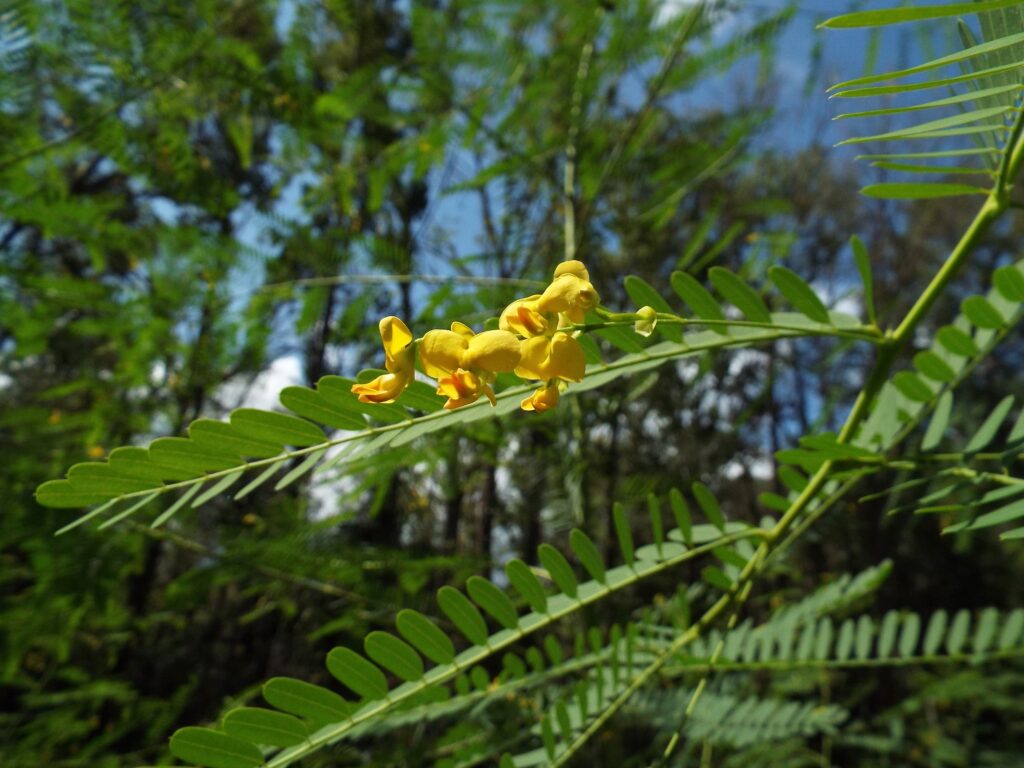
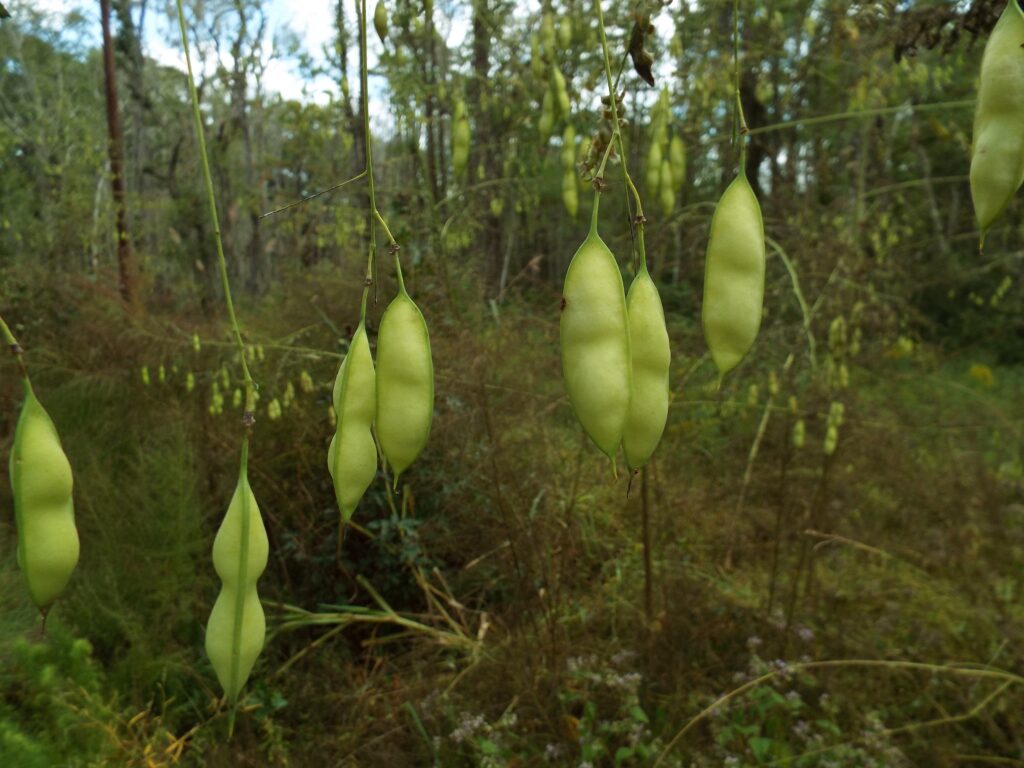

Bigpod and Bagpod are tall, stringy annuals that can exceed 12ft in height. They have narrow stems and branches and a very open appearance. Their leaves are long and divided into many small leaflets. Their thin stems are hollow yet quite stiff. This minimizes the cellulose needed to produce the same surface area of leaf canopy, which makes our Riverhemps quite strong competitors wherever they can find a foothold. By then growing together as a dense thicket, they can exclude competition for next year. Their tight knit clumping assures when their seeds fall each winter, there’s bare ground for them to take hold in each spring. Their leaves are a favored host for Zarucco Duskwing caterpillars and the large golden wooly-bear caterpillar of the Saltmarsh Moth. The seeds are nutritious and feed wetland rodents and marsh birds over winter. The hollow dead stems provide habitat for many cavity nesting pollinators, including bees.
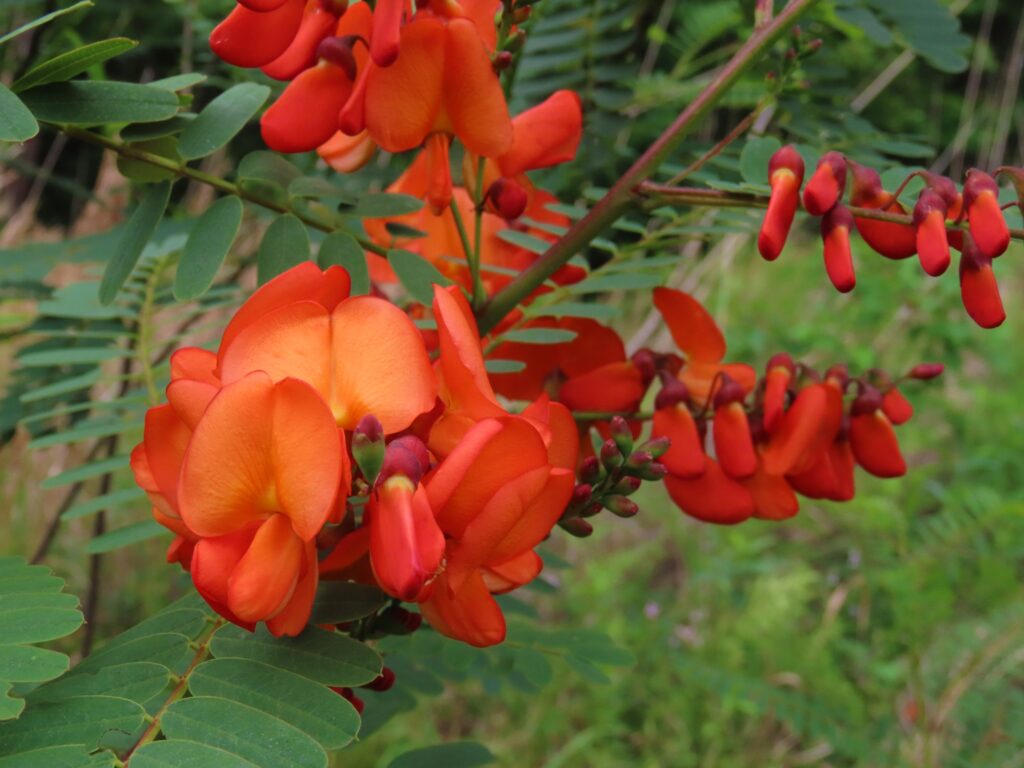
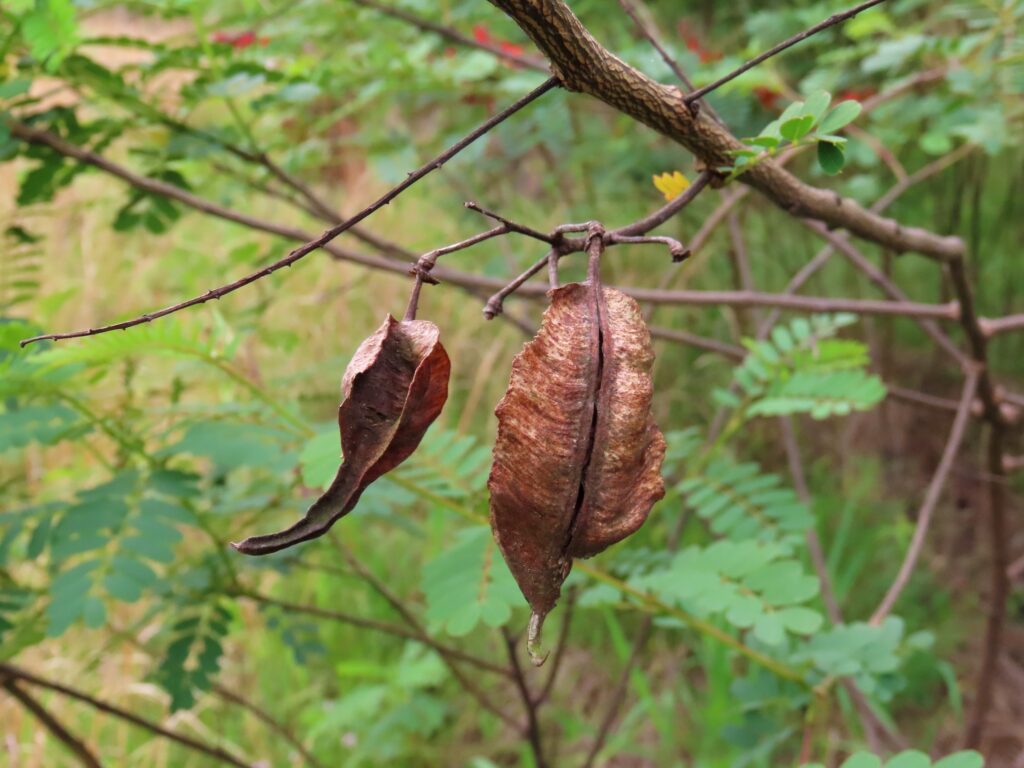
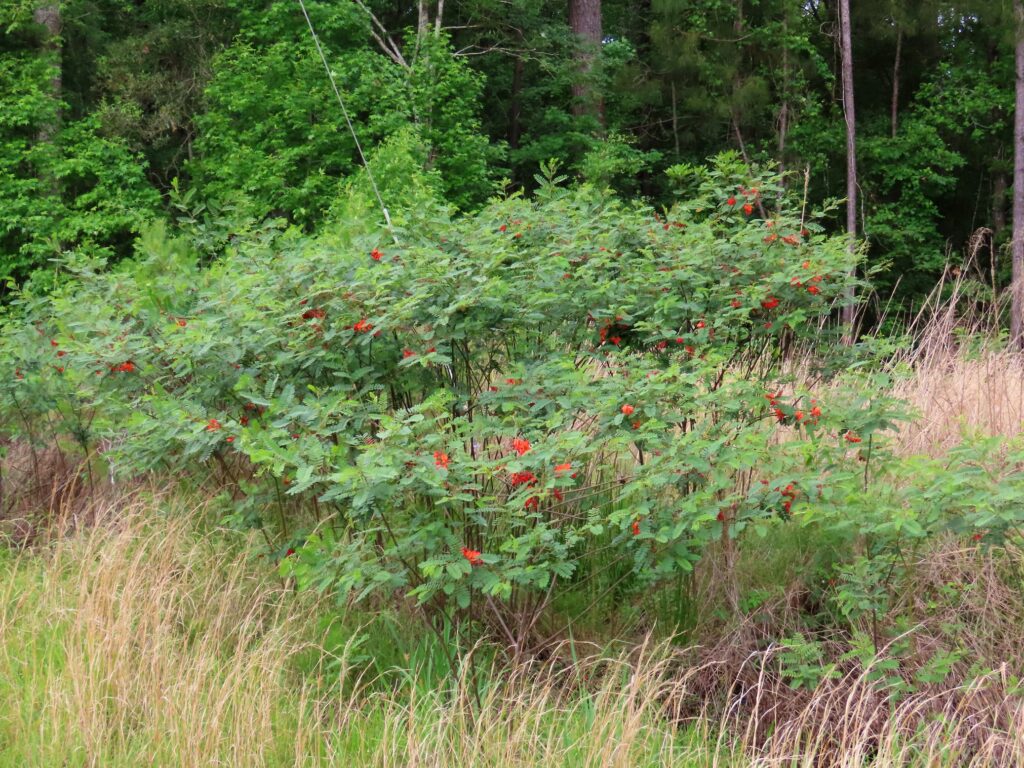
Purple Sesbane is an invasive exotic plant introduced from South America. It has wider leaves a darker green than the other two and a brown-green stem. The flowers are purple-red to orange, large, and in clusters of a half dozen or more. Purple Sesbane shares many of the same characteristics as our native Riverhemps but has a few other tricks that make it a net negative for the wetlands it weasels into. What is different about Purple Sesbane that makes it harmful to the ecosystem is that it is both poisonous and a perennial. This means that many of the wildlife benefits out native Riverhemps provide are not supplied by Purple Sesbane. Purple Sesbane is a perennial, so the dense 10ft tall thickets it forms don’t die back each year. The stems persist and leaf out each spring. This leaves no room for other plants to work their way into the thicket and break up the clump. It also provides no habitat to native bees. Both the leaves and seeds are toxic, so neither birds nor butterflies can use it for food. Since nothing eats the seeds, the thicket will spread uncontested outward until it fills the wetland.




This week for Flora and Fauna Friday we have the companion of cows, the Cattle Egret (Bubulcus ibis).
Cattle Egrets are a small, stocky egret with snow-white plumage, greenish-black legs, and a sunflower-yellow bill. In their summer breeding season they don a blonde mullet with matching bib and back. They are rarely seen alone and typically travel in flocks of one to two dozen birds. Cattle Egrets are common in flooded lawns and fields, near ephemeral wetlands, and roosting over ponds but they’re most often spotted between the knees of Cows and Horses in our sea island pastures. Wiggling their neck as they stalk through the grass and spearing the spiders, grasshoppers, and frogs scared up by the hooves of their neighbors. This is an example of a symbiotic relationship. The Egrets are protected from predators like Foxes and Bobcats by sticking close to their beefy buddies. The Cattle worry less about predators themselves as the keen eyes of the Egrets more surely alert them to threats. The trouble is, there weren’t cattle in the Americas until the 1600s. Neither were there Cattle Egrets.
Cattle Egrets are a curious case of a species’ self-made transoceanic range expansion. One that happened in modern history at that. Cattle Egrets are native to Africa. There they live in the savannas and marshlands amongst the Wildebeest, Zebra, Buffalo, and Antelope. Feeding between their feet and alerting them to the toothier mammals. In the 1870s, by chance, a few flocks of Cattle Egrets flew their way to Suriname in South America. Maybe they were swept there by a hurricane or maybe they hitched a ride on the trade winds. No one knows. By the 1940s they began showing up in the United States. Now they’re the most common Egret in North America. Surely a bird as numerous as the Cattle Egret would have found its way across the Atlantic before, no? Likely they did. Likely not once but dozens of times in the past. But before, there was nowhere for them to live. Colonization changed that and when the Cattle Egrets immigrated to South America in the Victorian era, they found Cows. Lots of Cows all over the place. From there it was just a hop, skip, and a jump to the pastures of the United States. Now the Cattle Egret is ubiquitous across the hemisphere. Here they fill the same niche they did back home. A new niche recreated by man a long way from home.
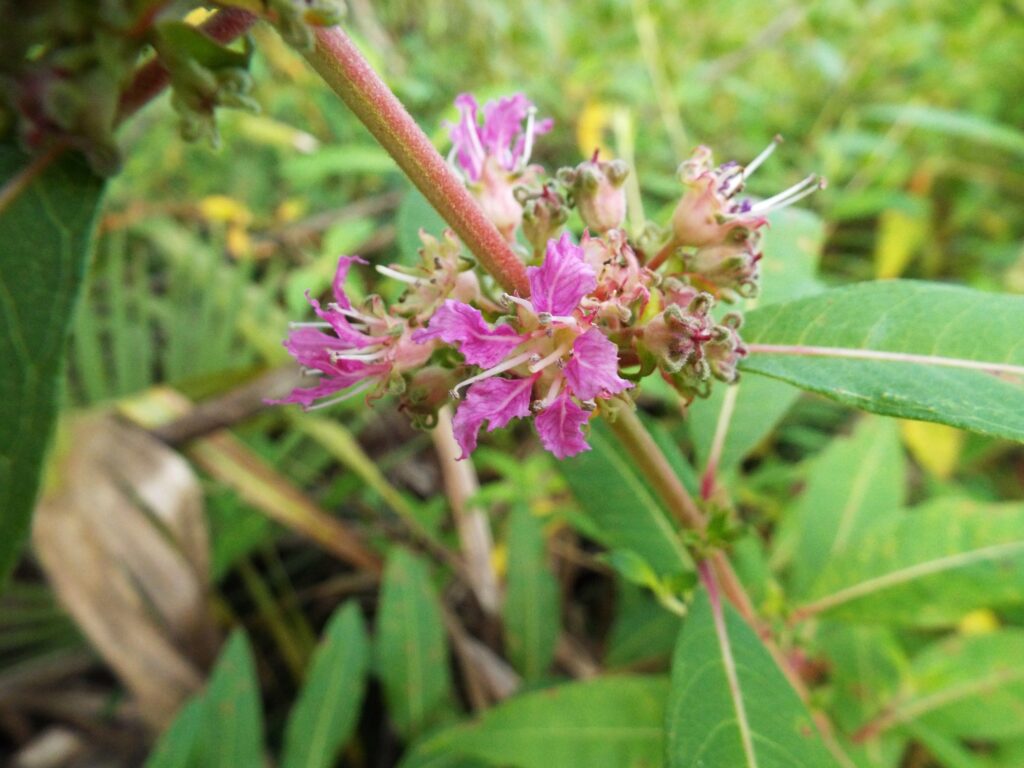
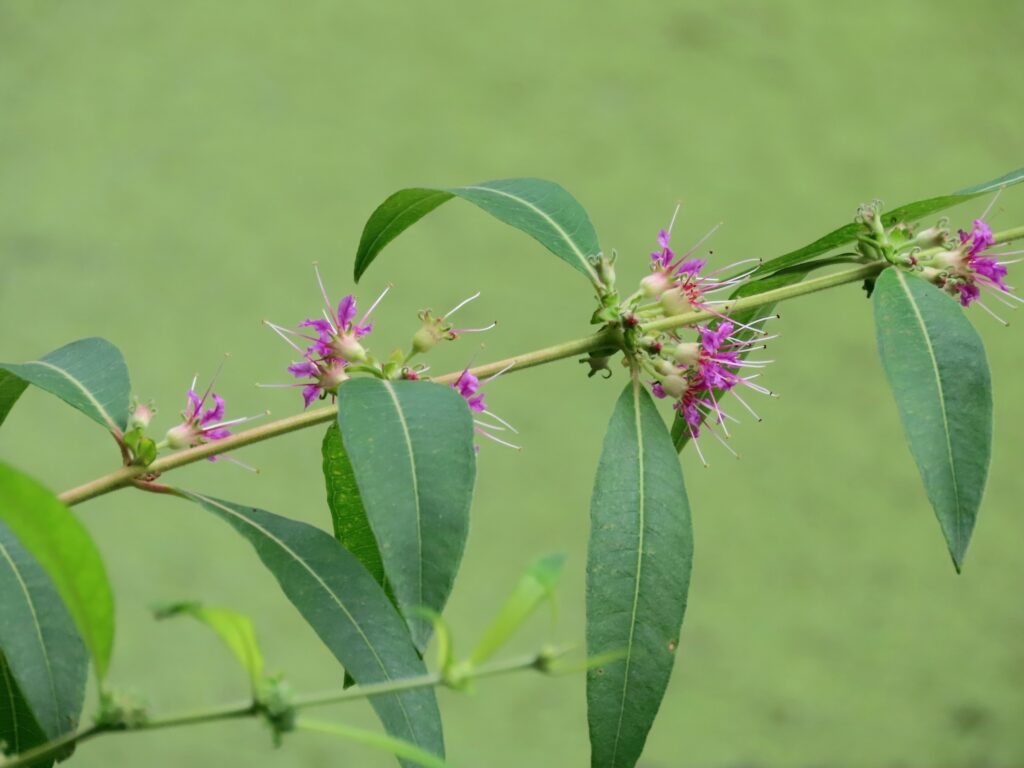
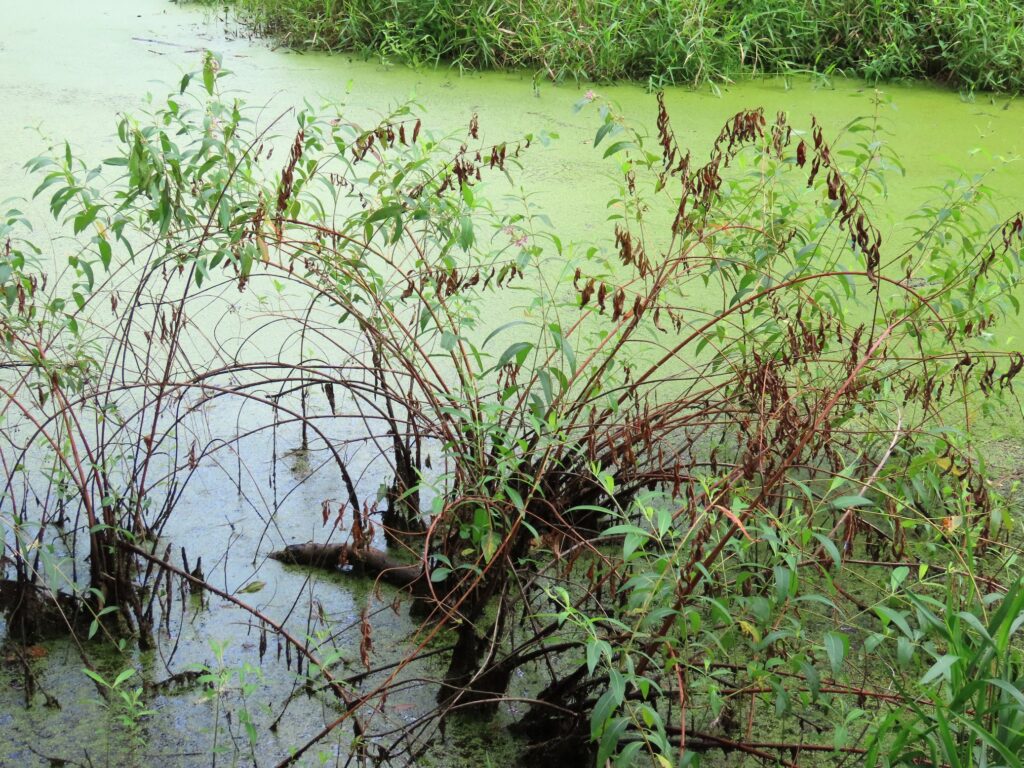
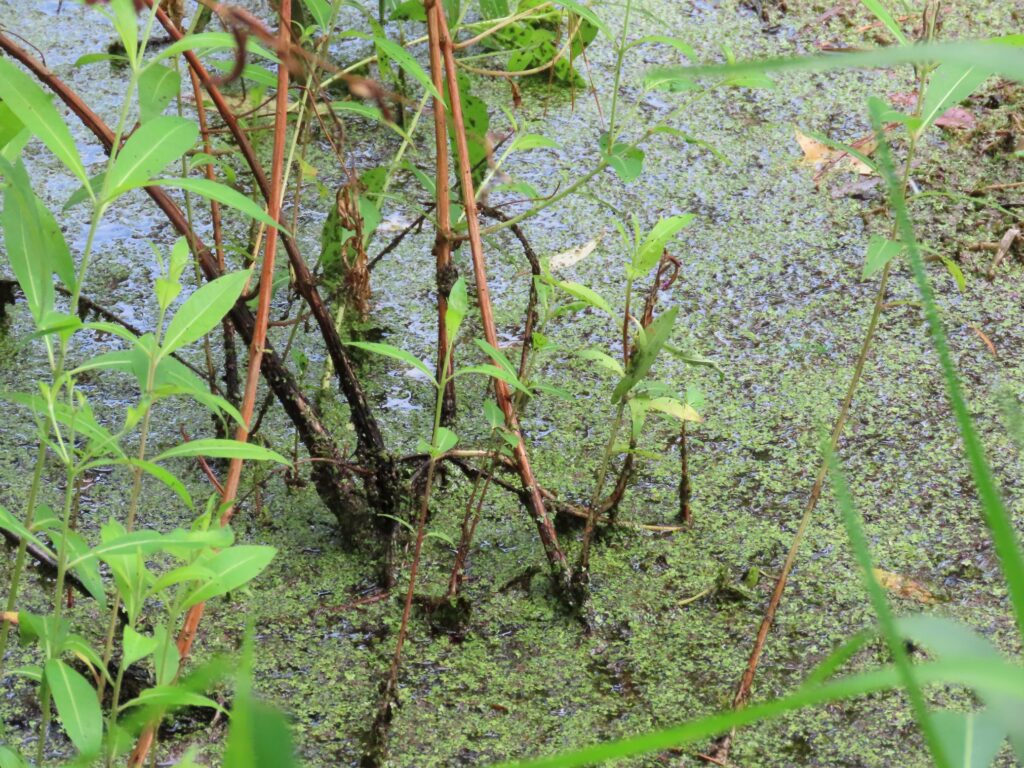
This week for Flora and Fauna Friday we have a purple plant of our marshy thickets, Swamp Loosestrife (Decodon verticillatus).
Swamp loosestrife is an herbaceous wetland shrub found throughout slow-moving freshwater marshes. This shrub can grow eight feet high in the saturated soils of our marshes. Simple, narrow leaves ladder opposite along the stem up from the muck before slipping back down. It’s slender arching branches tip-toe their way over the surface of the water, dangling down into the mud where they take root. This is an example of a plant that can spread by layering. Although Swamp Loosestrife typically dies back in winter before it can layer, it will do so if the conditions are right. Layering is the process by which a plant’s stem will produce roots when in contact with the soil. This process is quite common in vines and creeping plants but is not so often observed in trees or shrubs. Our loosestrife is an exception.
In late summer, Swamp Loosestrife puts on its grand display. Wrinkled magenta blossoms push their way through the nodes of the plant creating a network of floral chains as if a purple cast-net was thrown over the marsh. Yet, these petals are just the stage for the show. Swamp Loosestrife is an excellent nectar plant and with its blooms it brings forth butterflies. Palamedes Swallowtails, Long-tailed Skippers, Eastern Tiger Swallowtails, Silver-spotted Skippers, Cloudless Sulphurs, Clouded Skippers, Common Buckeyes, early Ocola Skippers, and a myriad more blanket the thicket, ensnared by the web of nectar. The fog of butterflies our loosestrife ushers in can be suffocating when the environmental conditions are right. The blooms attract not just butterflies but droves of bees, wasps, flies, and moths to boot. The flowers funnel in thousands of nearby pollinators per acre for this annual festival and toast to the muck of the marsh.
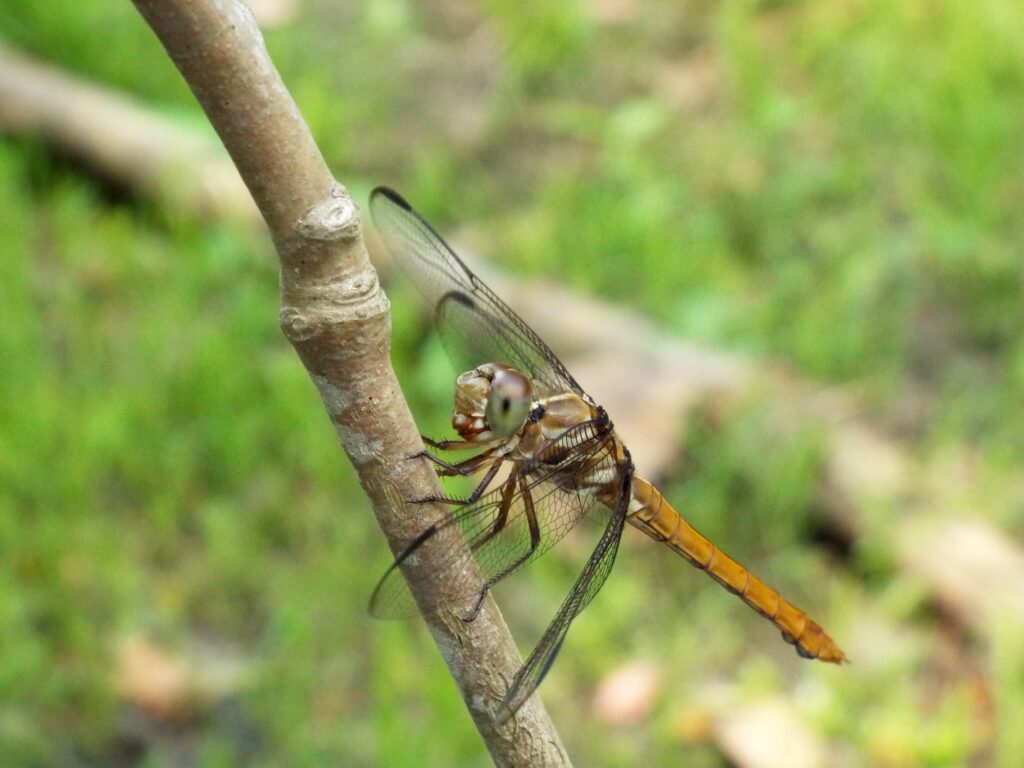
This week for Flora and Fauna Friday we have a flying hot pink insect, the Roseate Skimmer (Orthemis ferruginia).
The Roseate Skimmer is a member of the Skimmer dragonflies, our most common family of Odonates. Like most Skimmers, it’s partial to open areas above and surrounding bodies of water. Roseate Skimmers are most common in disturbed areas surrounding stagnant waterways. They show some preference for brackish systems and are especially numerous near unkempt retention ponds. Males are territorial and aggressive towards other dragonflies. They’re routinely seen incessantly flying the perimeter of their territory, darting back and forth across a stretch of pond, over and over, day in and day out.
Roseate Skimmers are about three inches in length. Both sexes have clear wings with dark stigmata. Females present a thorax striped with warm browns and creamy whites before an abdomen of a burnt orange-gold. Males are the showstoppers, flaunting a deep purple thorax above an abdomen almost glowing magenta. They are truly double-take worthy creature the first time you spot one. A sudden spark of violet catches the eye and, before you know it, you’re craning you neck and throwing your head trying to chase a sight of a pink sprite between the reeds. Although average in almost all other aspects, the Roseate Skimmer maintains a ubiquitous attraction in all us naturalists. It sits within the ranks of an exclusive group of unignorable items in our natural world. Critters that make us stop and appreciate the beauty of nature, no matter who we are.
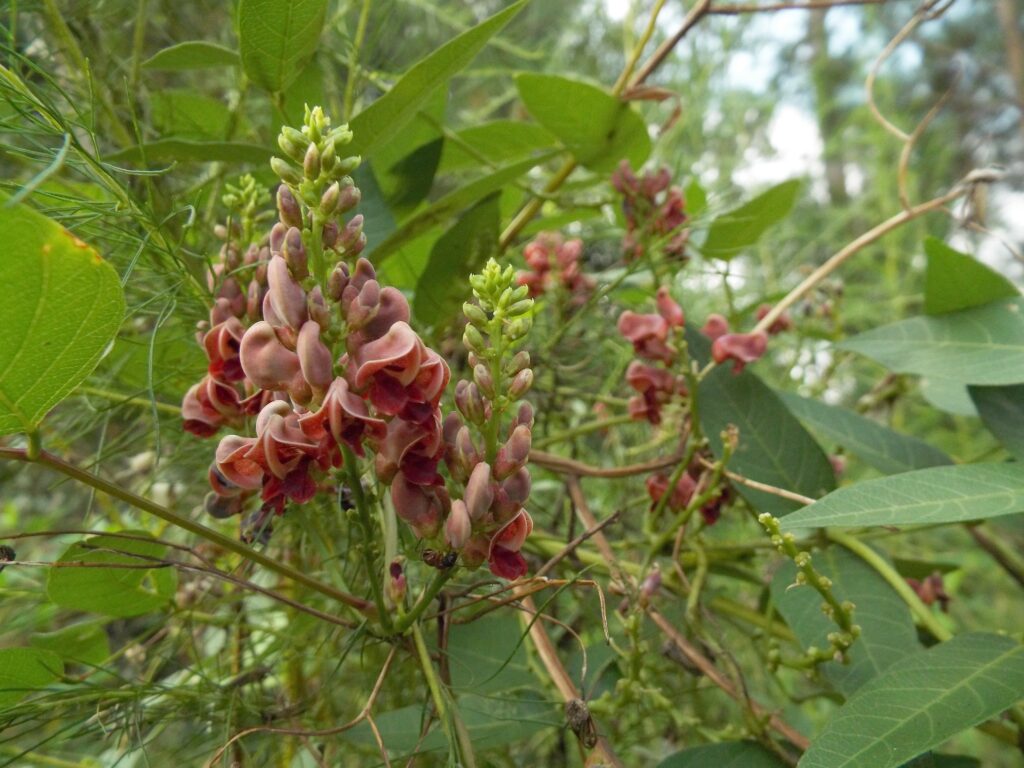
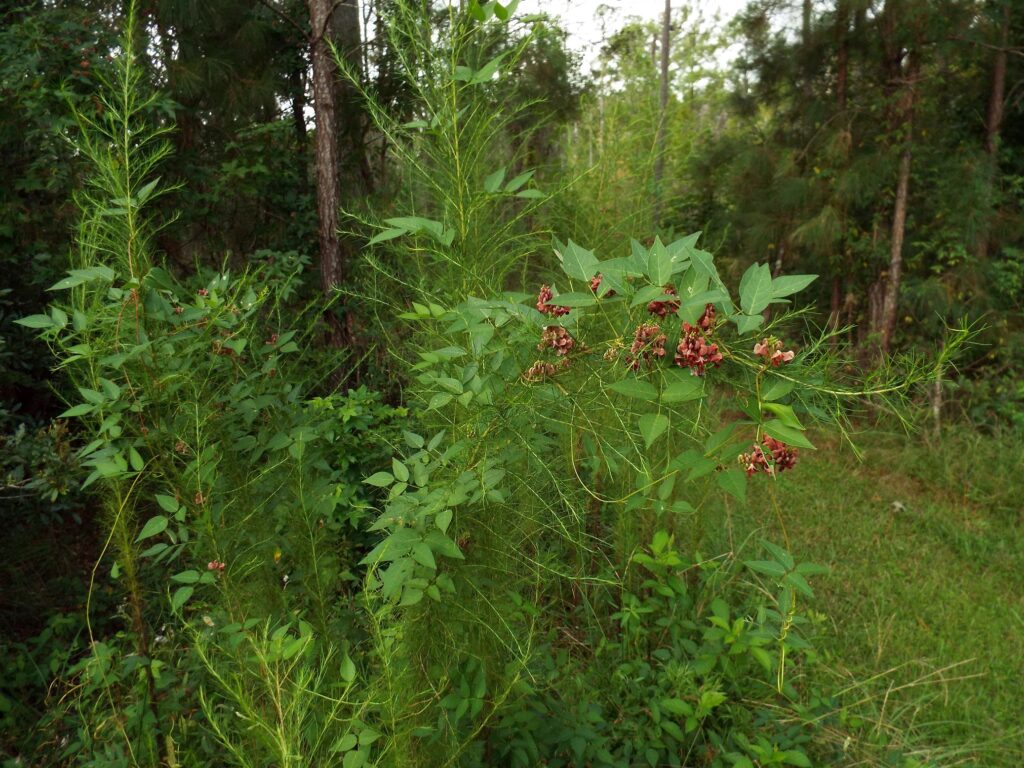
This week for Flora and Fauna Friday we have a palatable plant found in forests and fields, American Groundnut (Apios americana).
American Groundnut is a species of plant in the legume family. It’s a low growing vine that’s often found on the edges of moist fields and woodlots. It climbs by twining up grasses, shrubs, and herbaceous plants, sending out a pinnately compound leaf every few inches. The vines are thin and wiry, dying back to the roots each year. Its mauve-pink flowers clearly fit within its leguminous lineage and are presented in dense cones, spiraling upwards. The flowers are not large draws for pollinators but, like many legumes, the leaves are a favored host plant of certain butterflies. Silver-spotted Skippers lay their eggs on this vine and their red-headed, chunky green caterpillars can often be spotted pruning its vegetation throughout the summer.
Groundnut gets this portmanteau of a name from its tubers. Their tubers are about the size of a fig and found in strings beneath the soil along its subterranean stem. These underground nuggets are where the vine retreats each winter and they were a staple crop of some Native American peoples. Groundnut was grown as an undomesticated crop by Native Americans and used as an emergency food source by colonists. The tubers are very starchy and can be prepared in many of the same ways potatoes traditionally are. Apparently, they taste quite good, like a nutty potato. Although never fully domesticated by modern farmers, Groundnut has a distinct advantage as a crop in that it fixes its own nitrogen. This increases its productivity in tired soils and means it can be used as a green manure, like soybeans, peanuts, and rye.


This week for Flora and Fauna Friday we have an unmistakably minuscule acrobatic busybody, the Ruby-throated Hummingbird (Archilochus colubris).
The Ruby-throated Hummingbird is our only species of Hummingbird that appears with any regularity in South Carolina. They are our smallest bird, weighing only a few grams at adulthood. This unrivaled smallness gives them many advantages, as well as handicaps, that I’ll touch on later. Our Hummingbird has a pointed head drawing into a long, narrow bill. Their stubby wide tail, short triangular wings, and itty-bitty delicate legs give them quite a dainty appearance. Both sexes are a dusty white beneath with a verdant green back that sparkles with iridescence. Females are drabber with a white throat, tail-feather tips, and cheeks. Males possess a black eye-stripe that flows atop their jowls and onto a hot stoked-coal throat that smolders in the light like a winter sunset.
Ruby-throated Hummingbirds are common throughout the state wherever ample food can be found. They are specialized to drink nectar and can only survive where there are sufficient nectar plants to sustain them. Many plants have specialized their flowers to encourage Hummingbird visitation. Plants such as Crossvine, Coralbean, Trumpet Vine, and Red Buckeye. The pollen bearing structures and nectar glands of these flowers are positioned so as to maximize Hummingbird interaction. These plants are certainly favorites but Hummingbirds will take anything they can get. They will readily feed from any flower that produces sufficient nectar, including many exotic and ornamental plants like Manettia and Zinnia. Yet, they do have a clear preference for red flowers. Hummingbirds are not afraid to accept handouts either and will stake a claim to a properly stocked hummingbird feeder. (On an aside, do not use dyed hummingbird feed in your feeder. The dye is unnecessary and potentially toxic to the birds. Plain sugar water is best.) In addition to nectar, Hummingbirds will eat small insects and spiders. They also drink from sap wells created by Yellow-bellied Sapsuckers. These birds are quite feisty despite their stature and spend a good deal of time fussing and fighting over flowers.
Hummingbird habitat is so dependent of food availability because the birds have a ludicrously high metabolism. Their heart rate can exceed 1200 beats per minute and they consume an obscene amount of calories just to stay alive. Due to their small size, their metabolism must compensate to keep their core body temperature high enough. Their small size also means they can’t store much extra energy as body fat. So the birds must eat constantly or they’ll soon starve to death. So why do these birds want to be so small? The answer to that is what makes Hummingbirds so unique.
Hummingbirds are the most agile vertebrate on the planet. They have the ability to fly three dimensionally. They can move up, down, left, right, forward, or backward in any combination of those axes. They can fly at 25mph or hover stationary in mid-air. Their small size, along with some unique physiological adaptations, make all this possible. Their wings beat dozens of times a second, allowing for extremely rapid and fine flight control. This maneuverability allows these birds to access food sources, mainly treetop flowers, which were practically inaccessible to anything but insects before. Feeding in flight and not perching to feed reduced their risk of predation as well.
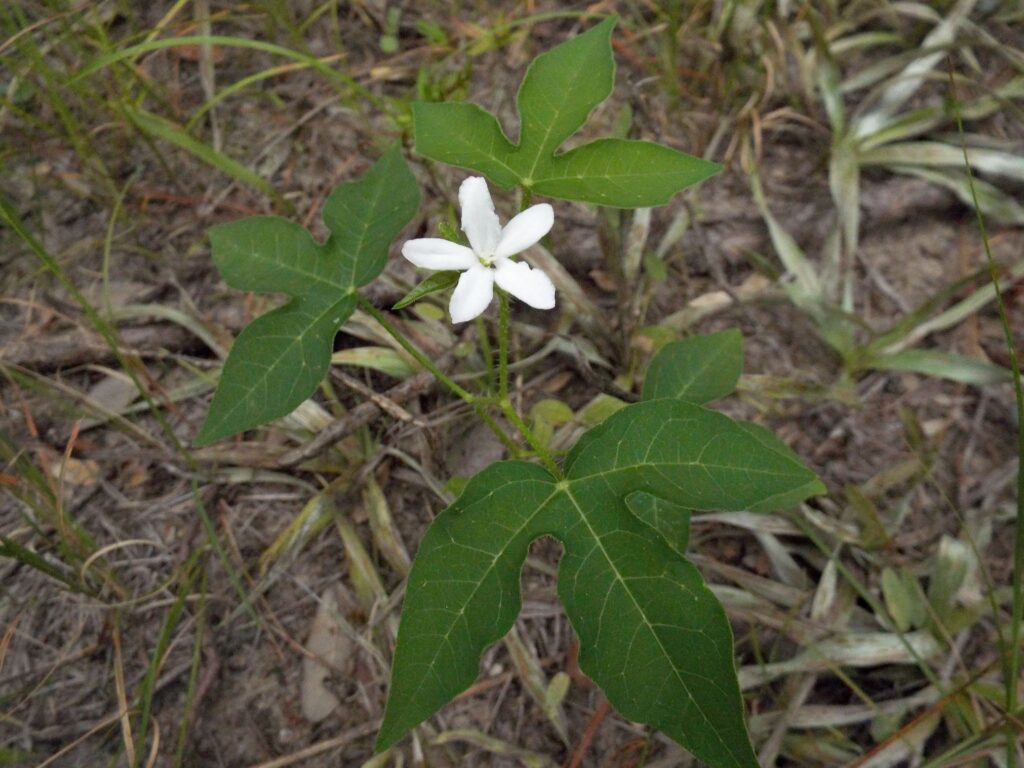


This week for Flora and Fauna Friday we have a modest and irritating wildflower, the Spurge Nettle (Cnidoscolus stimulosus).
The Spurge Nettle is a small perennial wildflower found in drier sandy soils across Edisto Island. It has largish palmate leaves with three or five lobes. Unlike true nettles, it’s a member of the Spurge family, Euphorbiaceae. As I’ve explained before, this family has some unique and complex floral anatomy. However, Spurge Nettle has converted that anatomy to something resembling a more traditional flower. Spurge Nettle has a brilliant-white five-petal flower. The flowers are monoecious, each being either male or female. It blooms nearly year-round. They have a robust taproot which helps them hang on in the dry, sandy, and often disturbed ecosystems where they are found. This taproot is edible when cooked but probably better off left alone as I’ll explain below.
Spurge Nettle’s claim to fame is its defensive nature. Spurge Nettle is veiled in an aura of urticacious trichomes. Trichomes are the tiny hairs found on the surface of a plant. They come in many different shapes with a multitude of purposes on a plethora of plants. Urticacious trichomes are meant to irritate. These stinging hairs are found across every surface of the Spurge Nettle, except its flowers. They protect the plant from herbivores by causing severe pain wherever the stinging hairs can reach. This irritation is induced by a poison injected by the plant. These trichomes have a tip that’s not even sharp. Instead the point is round and slightly swollen, like the tip of a wooden drumstick. Upon contact with an offending individual, that swollen tip snaps off across the waist beneath it. Breaking like glass, it leaves behind a hollow and incredibly sharp shaft. This microscopically sharp hair immediately and effortlessly punctures the skin as the pressurized liquid poison inside is injected into an unsuspecting critter. These trichomes are tiny pressurized hypodermic needles. The toxin is mostly harmless to humans but can be incredibly painful depending on the level of exposure. Spurge Nettle is a plant that’s best appreciated in the woods and not in the bouquet.